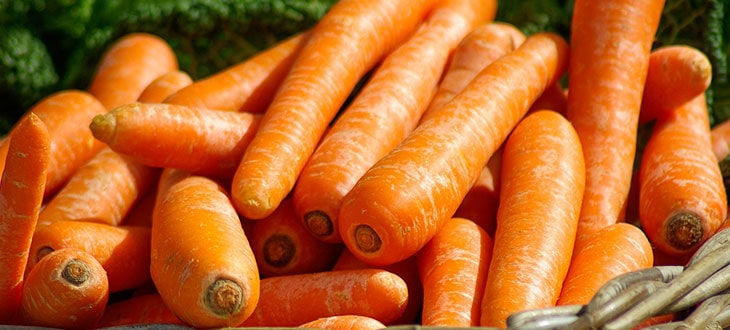7 Orange Vegetables List
Are you looking for orange vegetables? Below is a list of 7 of the most common vegetables that have an orange color.
Orange vegetables are not only appealing for their color but their consumption also has numerous benefits for your health.
The orange color in fruits in vegetables is given by a red-orange pigment (carotenoid) called beta-carotene.
Beta-carotene is a provitamin utilized by our body to produce vitamin A.
Provitamin A is only found in plants while vitamin A (known as “preformed vitamin A”) is also found in animal-based foods such as meat, eggs, fish oils, and various dairy products.
Our body can utilize the preformed vitamin A we take from animal products directly in its form. While that is an advantage concerning the absorption time, it also comes with disadvantages.
Unlike the provitamin A that we take from plants, the preformed vitamin A can build up to toxic levels in our organism if the intake is too high.
Beta-carotene is also an antioxidant that is essential in keeping our eyesight, skin, reproductive system, and immune system healthy. (source)
Now that you know the importance of eating orange-colored fruits and vegetables and what gives them this color, let’s list some of the most common orange vegetables.
Contents
1. Carrots
When we think of orange vegetables, carrots are probably the ones that come first to our minds.
Carrots are root vegetables belonging to the Apiaceae family. They are domesticated forms of the wild carrot (Daucus carota) and although most of us are only familiar with the orange variety, other cultivars of different colors also exist, such as yellow, white, purple, red, and black.

Not only are carrots easy to grow in the garden and give flavor to many recipes or are excellent when pickled, but their frequent consumption also carries numerous health benefits.
Carrots contain few calories, very low amounts of fat and cholesterol, and are very rich in antioxidants, vitamins, and fibers. They are also one of the best plant sources of beta-carotene and vitamin A.
2. Sweet Potatoes
Sweet potatoes are delicious and are available in the fruit and vegetable area of most supermarkets. Their consumption is beneficial to our health, so not infrequently, nutritionists advise us to include them in our dietary regime.
The sweet potato (Ipomoea batatas) is a root vegetable and belongs to the family Convolvulaceae. Its sweet tuberous roots are frequently consumed in various dishes such as soups, curries, pasta, salads, or even baked and served as desserts due to their sweet taste.

Although the most popular varieties of sweet potatoes have vibrant orange flesh, there are other varieties with white, yellow, cream, or purple cores.
Sweet potatoes contain high levels of alpha and beta-carotene and are an excellent source of fibers, vitamins A, K, and B6.
They are also known to reduce the risk of diabetes, obesity, and cardiovascular diseases, and contribute to skin health.
3. Squashes & Pumpkins
Pumpkin and squash are fall-specific foods, being valued for their sweet taste and because they are utilized in the kitchen in the making of various delicious recipes.
While botanically fruits, squashes and pumpkins are often treated as vegetables in culinary as they are not consumed in their raw form.
Both squashes and pumpkins are part of the Cucurbitaceae family and include both edible species and others with a more decorative role. The size and color of the fruits of these plants vary from one cultivar to another and their maturity level.
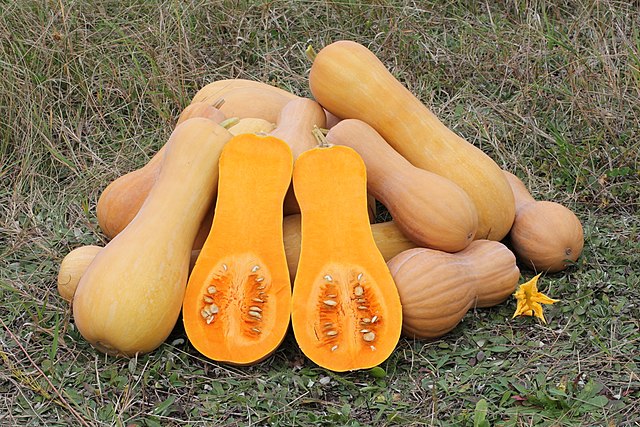
The core of mature pumpkin and squash fruits is typically orange and contains numerous seeds.
The fruits of these plants are also a rich source of vitamins and nutrients beneficial for health. Both the pulp and the seeds can be consumed.
Squashes and pumpkins are low in fats and calories and contain vitamins (A, B, C, E, K), minerals like magnesium, manganese, potassium, phosphorus, copper, iron, and antioxidants like alpha and beta-carotene, lutein, and more.
4. Orange Tomatoes
When we talk about tomatoes, almost all of us imagine them as red. However, there are several varieties of tomato plants that produce fruits of various colors when ripen. These include orange, pink, white, yellow, green, purple, black, and even striped.
A few popular cultivars of yellowish-orange tomatoes include:
- Kentucky Beefsteak
- Yellow Brandywine
- Amana Orange
- Tangerine
Although tomatoes are botanically fruits, they have always been referred to in the kitchen as vegetables.
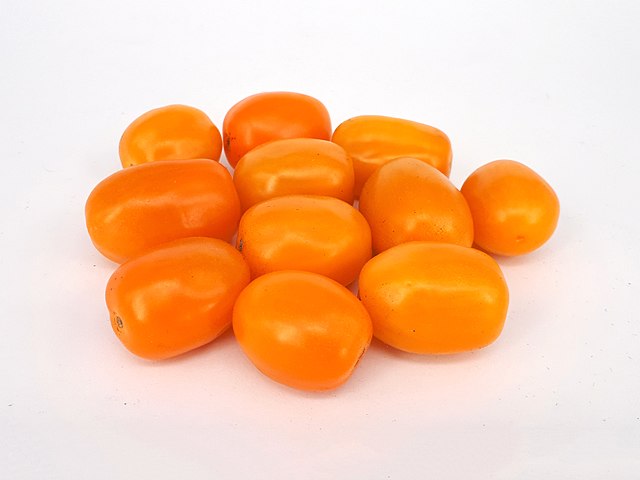
The taste of orange tomatoes is often close to that of red tomatoes, but there are some differences regarding the substances they contain.
According to Burpee, the red tomatoes offer high amounts of lycopene, a red carotenoid pigment and antioxidant that protects body cells from damage, while the orange tomatoes provide more beta-carotene, which is as mentioned earlier both an important antioxidant and also responsible for delivering Vitamin A.
5. Turmeric
Turmeric (Curcuma longa) is a perennial plant in the family Zingiberaceae, commonly known as the “ginger family.”
This plant is primarily cultivated for its rhizomes. These have a cylindrical shape, numerous thick ramifications, and a yellow-to-orange core.
Turmeric rhizomes are commonly used to obtain an orange powder that is used in cooking as a coloring or flavoring agent. To obtain this powder, the turmeric roots are usually boiled and then dried in the oven and ground into a fine powder.

The spice obtained contains an active substance called “curcumin.” Curcumin has certain beneficial properties, which is why it is also present in some food supplements.
Although there is not enough clinical data regarding the benefits of turmeric on the body, the root of this plant has long been used in traditional medicine.
Turmeric also has uses in gardening. Prepared and applied properly, it can be used as a natural pesticide and fungicide. At the same time, it is also a natural remedy for treating plant wounds due to its antiseptic and antibacterial properties.
6. Orange Bell Peppers
Regardless of their color, bell peppers are healthy and tasty vegetables, and are common crops in the gardens of many of us.
While they are botanically fruits, peppers are commonly regarded as vegetables in the kitchen.
Like other plants, there are many varieties of bell pepper.
When these fruits reach maturity and ripen, the peel and pulp of the most common varieties will acquire colors such as red, orange, or yellow. There are also lesser-known varieties that produce purple, chocolate, white, brown, or lavender bell peppers.
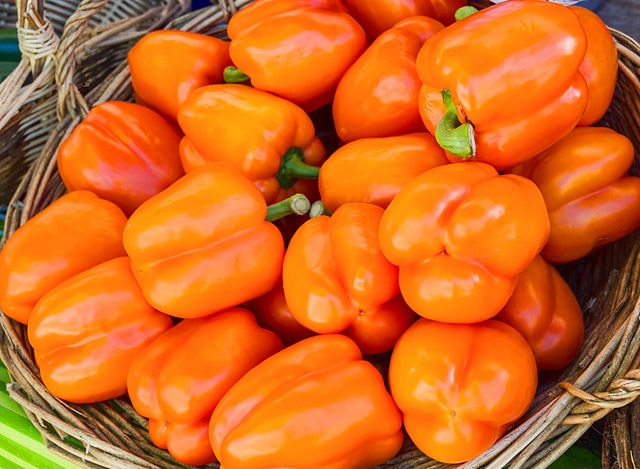
Green bell peppers are usually unripe and as they mature and ripen, they usually take on a different color depending on the cultivar.
There are differences between the taste of green and colored peppers, but that’s due to the fact that the green pepper is not yet ripe and not because of its color. As the fruit ripens, its sugar content also increases and it gets sweeter.
However, there are some differences in the nutritional values of different-colored bell peppers due to the carotenoid pigment that gives the fruit its color.
The consumption of bell pepper has anti-inflammatory, antiseptic, antifungal, and antioxidant effects. It contains important amounts of antioxidants, beta-carotene, vitamins C, A, B6, K, and E, as well as essential minerals.
7. Orange cauliflower
Either we eat it raw in salads, roasted, on pizza, in soups, tacos, pastas, or pickled, cauliflower is a valued and tasty vegetable in many cuisines.
Cauliflower is one of the several vegetables obtained through years of selective breeding from Brassica oleracea, also known as wild cabbage or wild mustard.
When we think of cauliflower, those big white heads come to our minds (also known as “curds”). What many don’t know is that besides the well-known varieties that produce those white yields, there are also other cultivars that produce orange, purple, and green cauliflower.
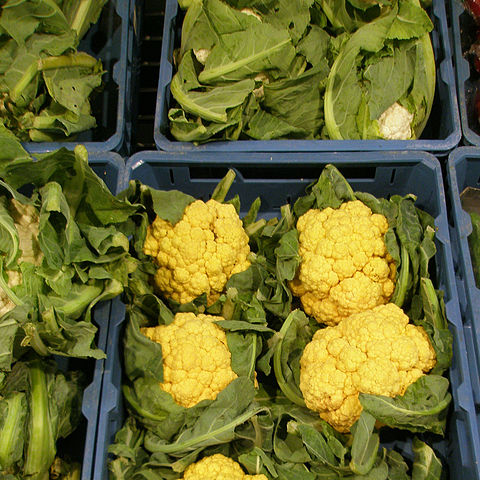
The orange cauliflower emerged as a gene mutation of the common white cauliflower. The hue of orange is given by its elevated content of beta-carotene. It is also commonly known as the “Cheddar cauliflower,” due to its aspect similar to Cheddar cheese.
Cauliflower is an amazing source of fibers, vitamins (C, B6, K), essential minerals (Potassium, Manganese, Magnesium, Phosphorus), and natural antioxidants. It is also very low in calories.
Final Word
These are some of the orange vegetables that we often grow in our gardens or use the kitchen to prepare various tasty recipes.
As mentioned at the beginning of the article, their color is given by a red-orange pigment called beta-carotene and which plays an important role in the production of vitamin A in our body. Thus, they do not only have a beautiful color, but are also healthy.
Besides these vegetables, there are also numerous orange fruits that also have a high content of beta carotene.

